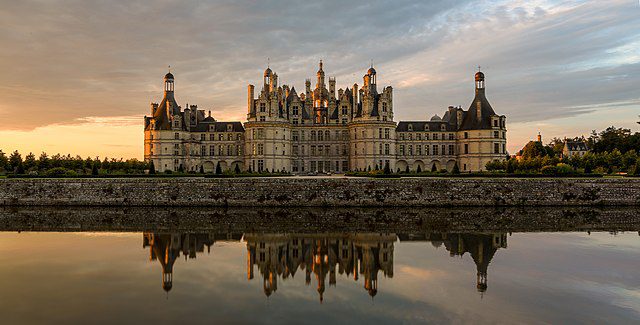
Château de Chambord is one of the most fascinating castles in the world. Nestled in the heart of the Loire Valley in France, it stands as a stunning example of Renaissance architecture. With its grand towers and intricate designs, this château has captured the imagination of historians, architects, and tourists alike. However, beyond its beautiful exterior lies a deep history filled with mystery, intrigue, and fascinating stories. This article will explore the origins, architectural marvels, legends, and modern-day allure of Château de Chambord, offering insights into why it remains a significant symbol of French heritage.
The Origins and History of Château de Chambord
Château de Chambord’s origins are as grand as its structure. King Francis I of France commissioned the château in 1519, during the height of the French Renaissance. He envisioned Chambord as a hunting lodge, but its grand scale quickly made it much more. The king’s decision to build this magnificent structure in the Loire Valley was strategic. The area was already home to many other royal residences, and Francis I wanted to showcase his power and influence through this architectural masterpiece.
King Francis I was known for his love of the arts and his desire to rival the grandeur of the Italian Renaissance. His admiration for Italian culture influenced the design of Chambord, blending French medieval forms with classical Renaissance elements. However, the château’s construction was never fully completed. Although work continued intermittently throughout Francis I’s reign, the project was so ambitious that it outlasted his lifetime. Even so, Château de Chambord became a symbol of the king’s legacy and an embodiment of the Renaissance spirit in France.
The history of Château de Chambord is closely linked to the political and cultural shifts of its time. During the 16th century, France was emerging as a major European power, and the château reflected the country’s growing influence. Despite its intended use as a hunting lodge, Chambord became a royal residence and a place for the king to entertain guests. The château’s construction was a significant financial burden, but it was also a statement of wealth and power.
Over the centuries, Château de Chambord has seen many changes in ownership and purpose. After King Francis I’s death, the château passed through the hands of various French monarchs and nobles. It was used as a hunting lodge, a military barracks, and even as a place of refuge during the French Revolution. Despite its many changes, Château de Chambord has remained a symbol of France’s rich history and cultural heritage. Its origins and history provide a fascinating glimpse into the past, reflecting the ambitions and ideals of the Renaissance era.
The Architectural Marvel of Château de Chambord
Château de Chambord is not only a historical monument but also an architectural masterpiece. Its design is a blend of medieval defensive structures and Renaissance innovation, making it unique among French castles. One of the most intriguing aspects of Chambord’s architecture is the rumored involvement of Leonardo da Vinci. While there is no definitive proof that da Vinci designed the château, his influence is evident in its design, particularly in the famous double helix staircase.
The double helix staircase is one of the château’s most remarkable features. It consists of two spiral staircases that twist around each other, yet never meet. This design allows people to ascend and descend simultaneously without ever crossing paths. The staircase is an engineering marvel and a testament to the ingenuity of Renaissance architects. Some historians believe that da Vinci himself may have designed this staircase, as it reflects his interest in geometric forms and innovative solutions.
Château de Chambord’s exterior is equally impressive, with its array of towers, chimneys, and decorative elements. The château’s symmetrical layout and intricate details reflect the influence of Italian Renaissance architecture, which was characterized by harmony, proportion, and classical motifs. The central keep, or donjon, is flanked by four massive towers, giving the château a fortress-like appearance. However, unlike medieval fortresses, Chambord was not designed for defense. Instead, it was meant to be a grand residence that showcased the king’s wealth and artistic taste.
The interior of Château de Chambord is just as impressive as its exterior. The grand halls, ornate ceilings, and expansive windows create a sense of openness and light, which was a departure from the dark, enclosed spaces of medieval castles. The château was designed to accommodate large gatherings and events, with spacious rooms that could host hundreds of guests. Despite its size and grandeur, many of the rooms were never furnished or fully completed, leaving much of the interior open to interpretation.
Château de Chambord’s architectural marvels are not limited to its design and layout. The surrounding grounds, including the extensive hunting park, add to the château’s grandeur. The park is one of the largest enclosed forests in Europe, covering more than 13,000 acres. It was originally used as a royal hunting ground, reflecting the château’s purpose as a hunting lodge. Today, the park is a haven for wildlife and a popular destination for visitors who wish to explore the natural beauty of the Loire Valley.
The Mysteries and Legends of Château de Chambord
Château de Chambord is steeped in mystery and legend, adding to its allure as one of France’s most enigmatic castles. One of the most enduring legends is the existence of hidden symbols and secret passages within the château. These stories have captured the imagination of visitors and historians alike, leading to various theories about the château’s purpose and design.
One of the most intriguing mysteries of Château de Chambord is the hidden symbols that are said to be embedded in its architecture. Some believe that the château was designed with secret messages, possibly related to the esoteric beliefs of the Renaissance. These symbols include geometric patterns, unusual carvings, and hidden rooms that may have held special significance for those who understood their meaning. While there is no concrete evidence to support these theories, they have become an integral part of the château’s legend.
Another mystery surrounding Château de Chambord is its unfinished construction. Despite its grandeur, the château was never fully completed, leading to speculation about what it might have looked like if finished. Some historians believe that the château was intentionally left incomplete, possibly due to financial constraints or the untimely death of King Francis I. Others suggest that the unfinished state of the château adds to its mystique, making it a symbol of unfulfilled ambition.
The château is also associated with various historical conspiracies, adding another layer to its enigmatic reputation. Some believe that Château de Chambord was used as a meeting place for secret societies or that it played a role in political intrigues during the Renaissance. These theories are fueled by the château’s remote location and its association with powerful figures of the time. While these stories are largely speculative, they contribute to the château’s image as a place shrouded in mystery.
In addition to its hidden symbols and conspiracies, Château de Chambord is rumored to contain secret passages and hidden rooms. These stories have been passed down through generations, with some claiming that the château was designed with escape routes and concealed chambers. While no definitive proof of these passages has been found, the possibility of their existence adds to the château’s allure. Visitors are often left wondering what secrets the château might still hold, waiting to be discovered.
Château de Chambord Through the Ages
Château de Chambord’s history spans several centuries, reflecting the changing fortunes of France and its monarchy. After the death of King Francis I, the château passed through the hands of various rulers, each leaving their mark on its history. Despite its grand design, Chambord was often left vacant, used only occasionally as a hunting lodge or a place of refuge.
During the 17th and 18th centuries, Château de Chambord experienced periods of neglect and revival. King Louis XIV, the Sun King, visited the château several times and made some improvements, but he ultimately preferred the more comfortable palace at Versailles. As a result, Chambord was often abandoned, with its grand halls left empty and its gardens overgrown. Despite this, the château remained a symbol of royal power and prestige, even as it fell into disrepair.
The French Revolution brought significant changes to Château de Chambord. The château, like many royal properties, was seized by the revolutionary government and its contents were sold off. For a time, Chambord was used as a military barracks, and its once-grand rooms were turned into quarters for soldiers. The château’s decline during this period was emblematic of the broader upheavals taking place in France, as the old order was dismantled and replaced by a new republic.
In the 19th century, efforts were made to restore Château de Chambord to its former glory. The château was returned to the royal family, and various restoration projects were undertaken to preserve its architecture and history. However, it was not until the 20th century that Chambord became a national treasure. During World War II, the château was used to protect valuable art, including works from the Louvre, from being looted by the Nazis. This act of preservation highlighted the château’s importance as a cultural and historical landmark.
Today, Château de Chambord is a UNESCO World Heritage site and one of the most visited castles in France. It stands as a testament to the grandeur of the French Renaissance and the enduring legacy of King Francis I. The château’s history, from its origins to its role in modern times, reflects the changing tides of French history and the resilience of its cultural heritage.
Visiting Château de Chambord Today
Château de Chambord is a must-visit destination for anyone exploring the Loire Valley. As one of the most iconic castles in France, it offers visitors a chance to step back in time and experience the grandeur of the French Renaissance. The château is open to the public year-round, with various tours and activities available to enhance the visitor experience.
When visiting Château de Chambord, several key areas should not be missed. The double helix staircase, located in the central keep, is a highlight of the château. Visitors can ascend the staircase, marveling at its unique design and the panoramic views it offers of the surrounding area. The grand halls and royal chambers are also worth exploring, with their ornate ceilings, expansive windows, and historical displays.
The château’s surrounding grounds are equally impressive, offering visitors a chance to explore the natural beauty of the Loire Valley. The extensive hunting park, which covers over 13,000 acres, is a popular destination for walking and wildlife spotting. The park is home to a variety of animals, including deer and wild boar, reflecting the château’s original purpose as a hunting lodge. For those interested in history, guided tours of the park are available, providing insights into its role in the château’s history.
In addition to its architectural and natural beauty, Château de Chambord hosts various events throughout the year. These include historical reenactments, art exhibitions, and cultural festivals, which offer visitors a chance to experience the château uniquely. The château’s management has made efforts to preserve its history while also making it accessible and engaging for modern audiences. These events are a testament to the château’s continued relevance as a cultural landmark.
For those planning a visit, it’s important to note the practical details. Château de Chambord is open daily, with extended hours during the summer months. Tickets can be purchased online or at the entrance, and guided tours are available in multiple languages. The château is easily accessible by car, with ample parking available, and there are also public transportation options from nearby cities like Blois and Tours. Visitors should plan to spend at least half a day exploring the château and its grounds, although a full day is recommended to fully appreciate its beauty and history.
Conclusion
Château de Chambord is more than just a castle; it is a symbol of France’s rich cultural heritage and architectural ingenuity. From its origins under King Francis I to its role as a national treasure, the château has played a significant part in French history. Its architectural marvels, from the double helix staircase to its grand towers, continue to captivate visitors and historians alike. The mysteries and legends that surround the château only add to its allure, making it a place of intrigue and wonder.
Visiting Château de Chambord is an opportunity to step back in time and experience the grandeur of the French Renaissance. Whether exploring its grand halls, ascending its famous staircase, or wandering through its extensive grounds, visitors are sure to be impressed by the château’s beauty and historical significance. As one of the most iconic landmarks in France, Château de Chambord remains a must-see destination for anyone interested in history, architecture, and culture.
To end with a quote that captures the essence of Château de Chambord, we turn to the words of French novelist Gustave Flaubert: “Travel makes one modest. You see what a tiny place you occupy in the world.” Visiting Château de Chambord is a reminder of the vast history that came before us and the incredible achievements of those who sought to leave their mark on the world.







